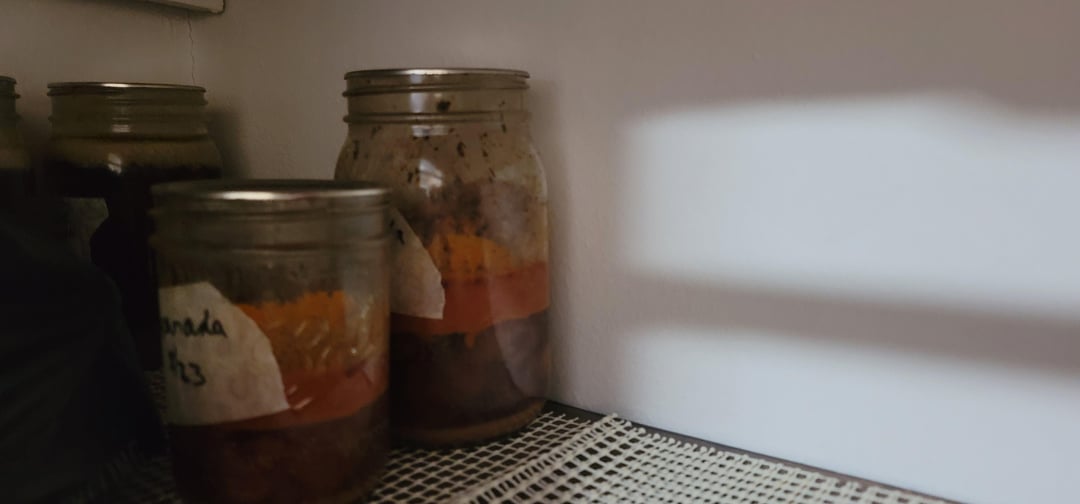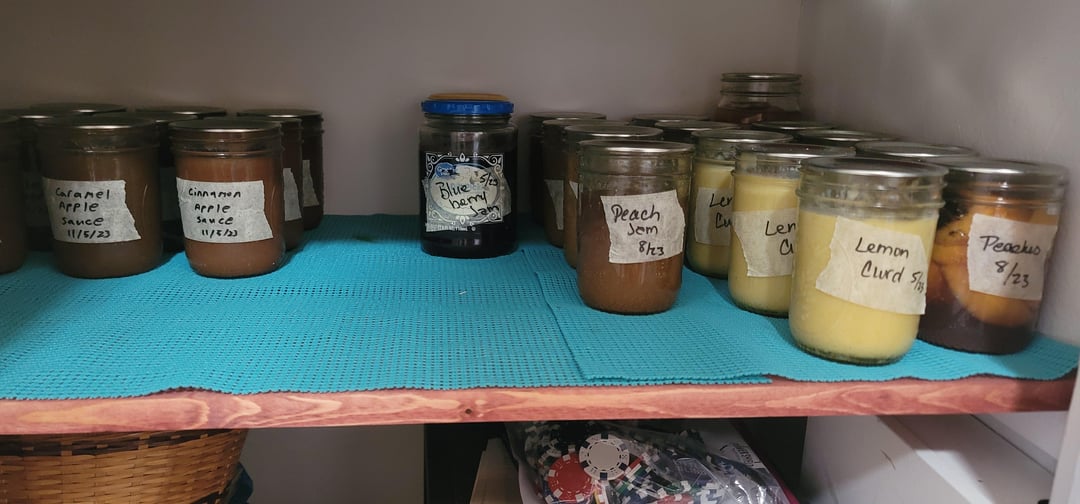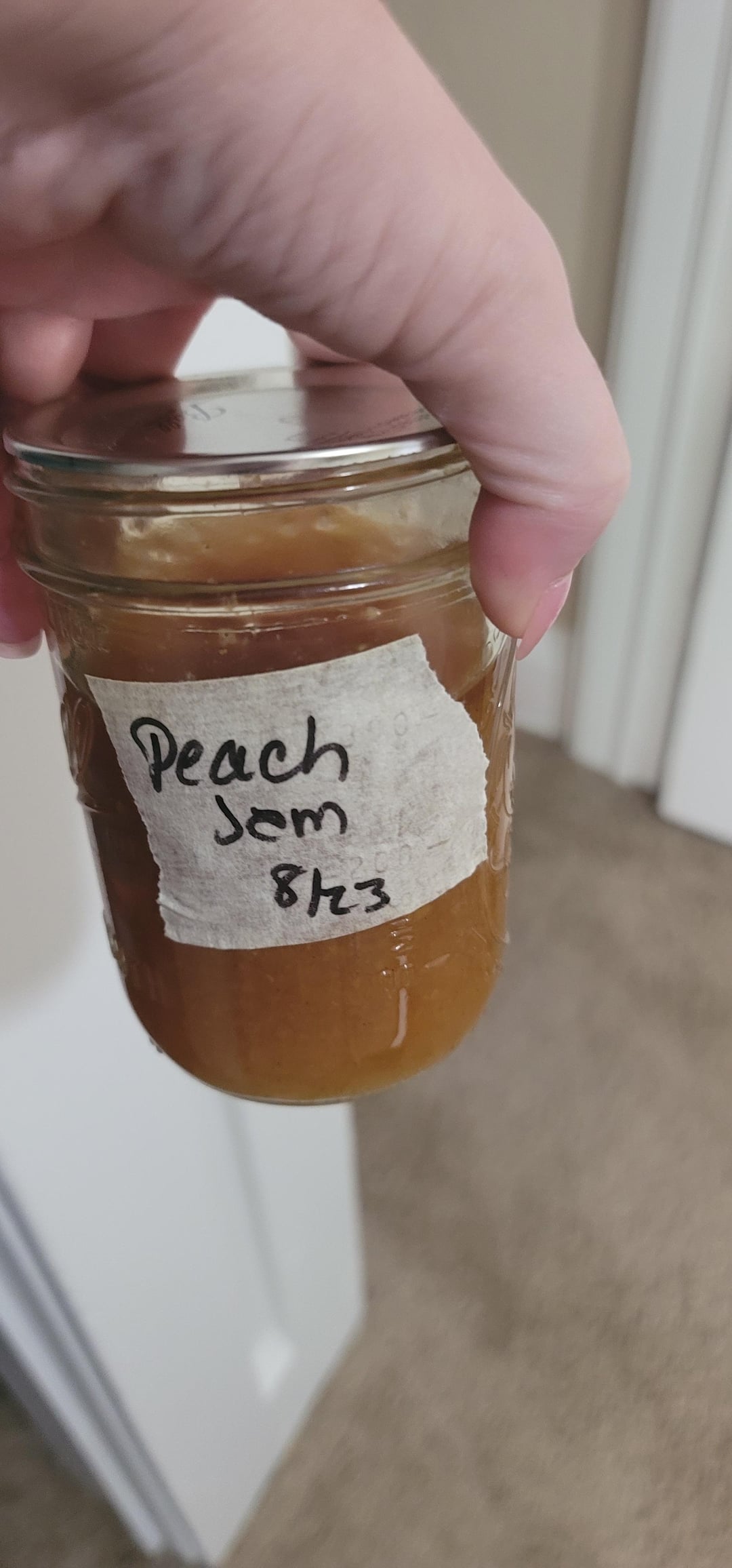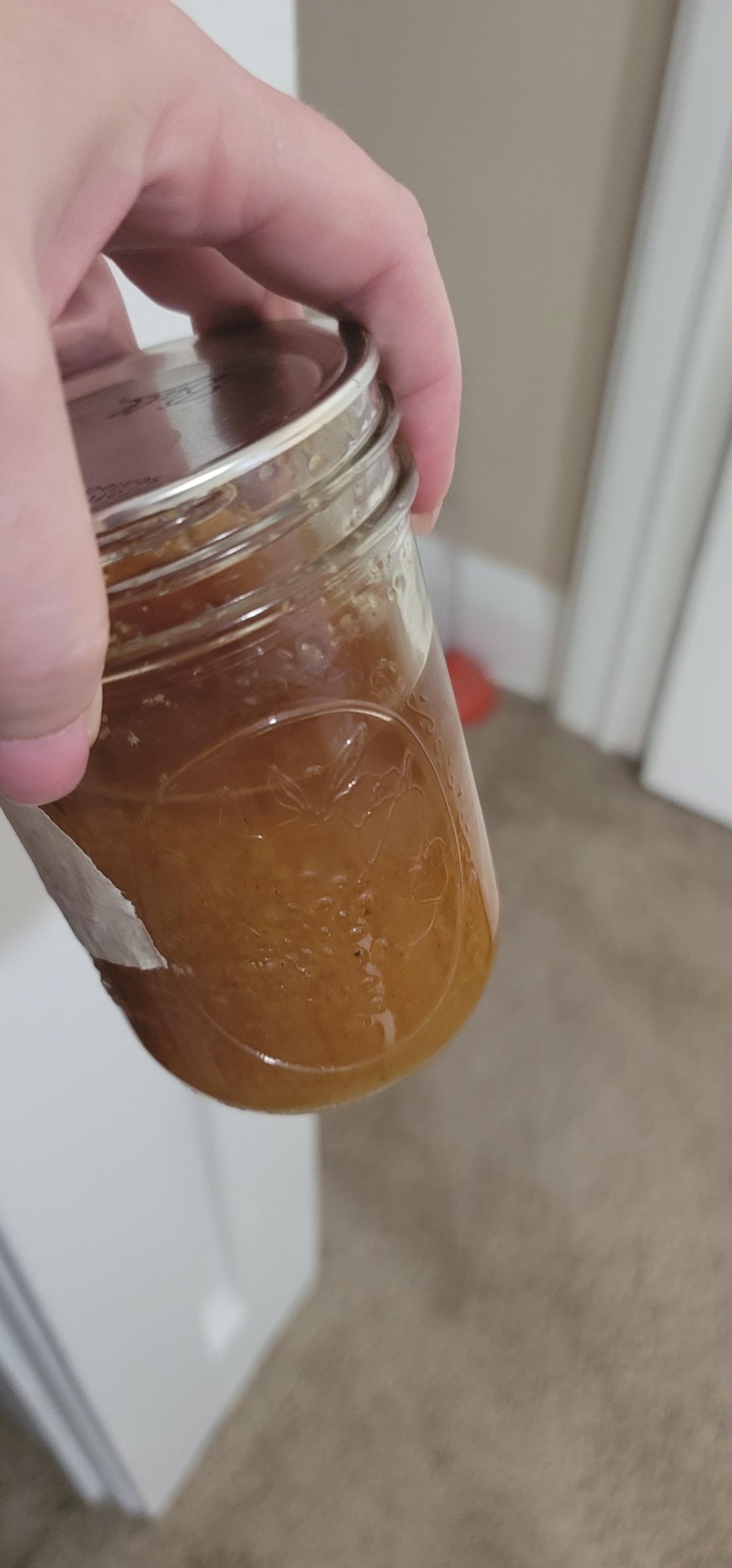




I have only been canning about a year and i dont do it often. I have one friend who cans, and until this sub I didn’t understand what rebel canning was, she rebel cans. All this is backstory to say, I’m here to learn and improve. Pics included of my closet. And some questions of course. 🙂
Peach jam – it didn’t set, there’s layers of water when I tip the jar.
Parsnips jars- I understand siphoning now, but are these safe?
Can I stack the pints?
I now know not to reuse jars but the pickle jars of jam, safe? Button is down but I know if u turn they will pop so is there another way to test or do I toss?
Top shelf is all pressure canned.
Bottom is water bath.
I know now not to store with rings on. I tested all the tops by trying to pull them offif they popped i tossed if they didnt i kept. Is there a better way to do this?
I’ll stop for now but I’ll be back!
by UrAntiChrist


16 Comments
Hi u/UrAntiChrist,
For accessibility, please reply to this comment with transcriptions of the screenshots or alt text describing the images you’ve posted. Thank you!
*I am a bot, and this action was performed automatically. Please [contact the moderators of this subreddit](/message/compose/?to=/r/Canning) if you have any questions or concerns.*
Sorry, none of these look safe to me. I’m more lenient than many folks in this sub, but even I wouldnt touch any of those. Headspace is all wrong. Never recycle a non-canning jar for canning. I don’t know how you canned those parsnips but unless they are pickled or pressure canned there is no way they are safe for waterbath canning.
Toss all of it. Follow only tested recipes. If you choose to branch out later that’s up to you, but at least you will learn the basics (importance of temp, headspace, pH, density, etc…) from tested recipes.
I would not eat a single one of those canned products! Take some time to research whatever safe canning procedures they use in your country and perhaps take a class if you can find one.
I use recipes from ball, uchfp and whatever manual came with my pressure canner. Make sure you’re following whatever headspace rules and processing times the recipe lists.
https://nchfp.uga.edu/how/can_home.html#gsc.tab=0
You can reuse rings but not actual lids. Don’t reuse commercial canning jars or lids. General rule is no canning dairy, butter, thickened foods. Make sure you pressure can when necessary and don’t use an instant pot or pressure cooker.
So much wrong here. Your head space is so inconsistent that there is no way you measured it. You need to measure it to the recipe because they tested how much space to leave to make a seal and not leave in too much air. It leads to faster spoilage and they won’t last the full 18-24 months most home preserves can last. Even if it isn’t dangerous (which it very well could be) the taste will absolutely be affected negatively. If you’re an American you’re tax dollars funded the food scientists that tested recipes at extension offices. Enjoy the fruit of your labor. They did the hard part for you and you already paid them for it.
You can only reuse commercial jars and lids for things that aren’t shelf stable. Think refrigerator pickles that you’ll eat in a few days though it’s best to use them for dry storage. Shelf stable jars and lids are made from thicker glass and precisely measured lids so that the seal won’t break over time. Doesn’t matter if the button is pressed down. Commercial lids were designed to be sealed with multimillion dollar machines. You physically can’t seal them properly at home.
You need to follow tested recipes. Pectin is rather precise and won’t set if anything at all goes wrong. I know people love making up their own recipes but unless you’re making some obscure local delicacy there is a recipe that’s what you’re looking for or very close. Dry spices can be added to taste to make it more personalized.
I know we seem a bit neurotic but people can and have died from doing this wrong. One death is too many when we have ways to prevent it. Look up the France Botulism case that happened recently.
Unfortunately, these items do not look safe to eat. It’s okay – we all make mistakes when we start out.
Following tested recipes is the easiest way to get delicious and consistent results.
And to your question – it is recommended not to stack cans because it can make them seem to be sealed when they really are not.
There is absolutely no shortcuts to canning and do not listen to anybody who tells you otherwise. As others have stated, botulism will kill you and you must absolutely read and follow the directions carefully. It’s not hard and it’s proven and tested, so why take the advice of someone who doesn’t know what the heck they’re doing?
One thing I noticed is your severe lack of liquid in the jars of orange chunks. You probably released all the steam from the canner at once instead of letting cool down naturally (which takes an hour to several hours). The faster it cools off, the more siphoning you have and you’ll have jars with low liquid and not as much head space. I learned the hard way on that my first time pressure canning too.
If you *know* you followed a safe recipe/process exactly, consider them safe. If not… consider them an expensive learning experience.
How did you pressure can them? Did you follow all the proper instructions? You shouldn’t have lost that much liquid. Did you clean the jar rims before putting the hot seals on? As far as the jelly looks like you didn’t put the proper pectin amounts and sugar in. From the pictures like the rest of the community said, I would not recommend eating any of these. Better to throw them all out and try again. Canning has to be really precise and you can’t skip any instructions. If it says add salt make sure you put it in. Lots of veggies with low acid content need the salt to make it safe and pretty much every veggie needs to be pressure canned. You can get away with doing a water bath for jelly and tomatoes. But honestly I just use my pressure canner for everything. Just keep trying and good luck!
Also for your question, I do not personally stack jars
One more thing, I always fill each jar to right under the lip of the top of it. About 1 inch from the lid if that makes since. Most recipes call for that amount in each jar.
I don’t know what “rebel canning” is exactly, but I can make a guess and it sounds like a good way to make yourself and/or others sick (at best) or worse.
USDA guidelines exist for a reason, to ensure the safety of our food supply. Yes, generations of my family survived open kettle canning their pickles. I choose to take the extra time to process them according to modern guidelines.
So, by no means am I a professional cook or scientist, but I would strongly recommend you read an official book published by Ball (complete guide to canning or something like that).
The concern with canning is food poisoning—particularly botulism (what I like to call involuntary Botox as botox is derived from Botulinum Toxin). This cost a pretty penny to treat, if it does not kill you. When I began canning I was nervous so looked up signs so if my son noticed them, he could take appropriate action. Nonetheless all was kosher. Botulism thrives in a environment without oxygen… When you create the vacuum by processing (without the proper acidity)…You may optimizing the chance for botulism to grow.
Without coming down on you, you should study that book—insofar as understanding what causes problems. When they do studies of individuals who have food poisoning through home canning the vast majority have issues because the item was improperly canned.
I personally also recommend pH strips… While you are not to deviate significantly from recipes, there are some caveats such as dried herbs/spices. The pH strip is kind of a basic test to ensure that it is too acidic to cultivate botulinum toxin (because things dont grow if the environment is too acidic).
Canning can be a great way to save money, but you have to be very precise when following the directions. Get yourself a ball blue book.
I don’t reuse any commercial jars. I don’t reuse any lids, only rings.
Don’t be in a rush. Read the directions a few times before you even start to prepare the ingredients. Don’t substitute.
Botulism is a real risk. You can die.
Make sure you have all the proper tools for canning. Make sure everything is clean. Read the directions once more.
It might help if you post what you are planning to can and the instructions. This way more of us can answer questions you might have about that specific item. You can do this!
WTF is rebel canning? Grew up in a canning household and I wouldn’t touch(eat) ANY of these jars; grandmother and all of my aunts & tias canned all of our pantry stuff my whole childhood. We also did our own pastas. Where are all the rings that should be on these jars? Those ensure that the process is secured and stable after you’ve pressure cook the jars to sterilize and pressurize them.
*None* of this looks safe. Especially the jam (?) in the repurposed jar. Big no-no.